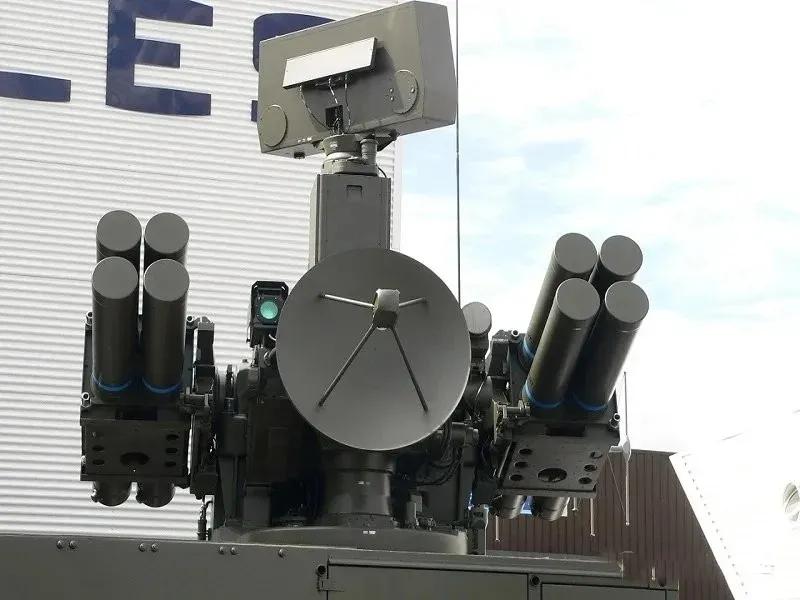
Crotale NG (Next Generation) is an all-weather short-range multi-sensor air defense system developed by the French company Thales Air Defense, capable of front-line armored brigade defense, permanent or semi-permanent field defense and area defense against fixed-wing aircraft, attack helicopters, cruise missiles, tactical missiles, and saturated attacks of confrontation weapons launched from aircraft and helicopters.
The Crotale NG system has a scalable range of detection capabilities such as air condition and threat assessment, friend or foe identification (IFF), multi-target detection, and automatic acquisition, tracking, and engagement, as well as 24/7 operation. Its data exchange capabilities enable the integration of Crotale NG into global air defense programs.
Four Crotale NG units form a row and operate in synergistic mode through automatic data exchange from computer to computer. Based on the results of the threat assessment and the relative positions of the four units, the units in the best position engage the target.
Design and R&D
The Crotale NG was put into production in 1990 and served in the Finnish Army, French Air Force and Navy. It was exported to the Hellenic Air Force and Navy in 1999, and the system has since been sold to Saudi Arabia and Oman.
In February 2000, Taylors and Samsung jointly received a contract for the Chun Ma K-SAM (South Korea Surface-to-Air Missile) project, which included the production of 48 Crotale NG surveillance and fire control systems.
In June 2018, the Finnish Defence Force successfully conducted live-fire tests of the Crotale NG system integrated with the Thales advanced Catherine XP thermal imaging camera.
System architecture
The Crotale NG missile defense system is equipped with both radar and infrared sensors to provide the best view of air targets. The subsystems are integrated into a single vehicle to form a stable and compact platform.
The system can perform operations that detect, intercept and respond to hostile threats such as drones, rockets and helicopters, and protect fixed or mobile military and civilian installations from air threats. The latest upgrade is equipped with an advanced thermal imaging camera that guarantees reliable real-time imaging day and night.
With a warhead load capacity of 13 kg, the system is capable of firing a warhead at a speed of up to Mach 3.5 to strike targets up to 11 km away.
Features of the VT-1 missile
The VT-1 missile is a short-range surface-to-air missile for land- and sea-based operations with a high degree of maneuverability, a load factor of 35G, and the ability to fly 8 kilometers in 10.3 seconds at speeds above Mach 3.5. The missile is propelled by a solid propellant rocket engine with an effective range of more than 11 kilometers.
The guidance method is line-of-sight command (CLOS) guidance based on radar and photoelectric sensors. The missile is equipped with focused explosion and fragmented warheads, activated by an RF close-range explosion fuze; The warhead provides a lethal blast radius of 8 meters. At a distance of 8 kilometers, the typical interception time from firing to destroying an aerial target is 10.3 seconds.
Fire control and surveillance anti-aircraft missile systems are equipped with multi-sensor components, including passive optoelectronics and built-in electronic countermeasure (ECCM) radars, which can engage air targets under adverse conditions such as intensive electronic warfare, hostile battlefield environments, nuclear, biological and chemical warfare.
The sensor assembly includes an S-band pulse Doppler surveillance radar that can perform sectoral surveillance, mobile search tasks, and a built-in IFF antenna. Electronic countermeasure functions include low side lobe, frequency atrocity, pulse compression, CFAR (constant false alarm rate), etc. The range is 20 km and the altitude coverage is 0 to 5000 m. In addition, the Ku-band traveling-wave tube single-pulse Doppler tracking radar beam width on the missile system is 1.20°, and the range can reach 30 kilometers.
The photoelectric tracking system consists of a thermal imaging camera with dual field of view and electronic magnification with an azimuth of 8.1 or 2.7°, a pitch angle of 5.4 or 1.8°, and a range of up to 19 km. Daylight CCD cameras have a field of view of 2.4°azimuth and 1.8° pitch, and the camera has a detection range of up to 15 kilometers. Infrared positioners are mounted under CCD cameras for missile information gathering.
All functions from target detection to tracking are automated, and the reaction time between the first detection and missile launch is reduced to 6 seconds. After the missile is launched, the operating software selects the best missile tracking sensor based on the data provided by all the sensors; The operator can choose to override the sensors automatically selected by the operating software.
Crotale Mk3 long-range anti-aircraft missile system
Thales developed the Crotale Mk3 as a long-range version of the Crotale NG missile. Its maximum effective range is 16 kilometers and its altitude is 9000 meters. With the help of the new Shikra